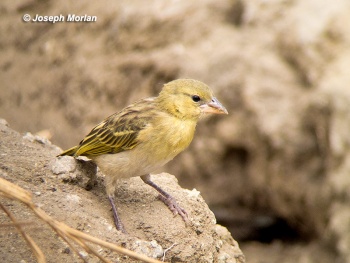- Ploceus vitellinus
Identification

Photo © by Carole-Anne
Serengeti National Park, Tanzania, 23 July 2010
12-14 cm (4½-5¼ in)
Male in breeding plumage
- Black facial mask shows a clear cut off at the chin.
- Bright yellow underparts
- Red eye.
Female and non-breeding male are olive above and yellow below, sometimes with a reddish eye. Juveniles similar with paler belly.
Similar Species
Very similar to Southern Masked Weaver but their ranges do not overlap. Vitelline's bill and mask are smaller than in other masked weavers and the mask is neatly rounded on the throat.
Distribution
Africa. Southwest Mauritania, Senegal, Gambia, Guinea-Bissau, southern Mali, Burkina Faso and Ghana east to southern Chad, northern Central African Republic, southern and eastern Sudan, South Sudan, northeast Democratic Republic of the Congo, central and southern Ethiopia, northwest and southern Somalia, northwest Uganda and north-central Kenya south to central Tanzania.
Taxonomy
Formerly lumped with Southern Masked Weaver (P. velatus), Katanga Masked Weaver (P. katangae), Lufira Masked Weaver (P. ruweti) and Tanzanian Masked Weaver (P. reichardi).
Subspecies
Two subspecies usually recognized[1].
- Ploceus vitellinus vitellinus: Senegal to western Sudan.
- Ploceus vitellinus uluensis: Ethiopia to Kenya and northern Tanzania.
Differences are variable and some authors consider the species to be monotypic [2].
Habitat
Dry savanna woodland and arid scrubland.
Behaviour
Diet
Includes seeds and insects, also nectar from Leonotis nepetifolia; birds will bite flowers off at base to steal nectar.
Breeding
They are polygynous nesting in small colonies in trees. The male builds an onion shaped nest from woven green grass. Clutch of 2-4 variable blue-white, pink-white or greenish, white eggs sometimes with fine black spotting, others with red or violet flecks.
Vocalisation
Song is a dry sputtering squeaky trill, interspersed with rasps, whistles and chirps.
Movements
Nomadic flocks form in non-breeding season. Movements likely, influenced by food supply.
References
- Clements, J. F., T. S. Schulenberg, M. J. Iliff, S. M. Billerman, T. A. Fredericks, B. L. Sullivan, and C. L. Wood. 2019. The eBird/Clements Checklist of Birds of the World: v2019. Downloaded from http://www.birds.cornell.edu/clementschecklist/download/
- Craig, A. (2020). Vitelline Masked Weaver (Ploceus vitellinus). In: del Hoyo, J., Elliott, A., Sargatal, J., Christie, D.A. & de Juana, E. (eds.). Handbook of the Birds of the World Alive. Lynx Edicions, Barcelona. (retrieved from https://www.hbw.com/node/61024 on 13 February 2020).
- Zimmerman, D.A., Turner, D.A., Pearson, D.J. (1996) Birds of Kenya and Northern Tanzania, Princeton University Press, Princeton, NJ, ISBN 0-691-01022
Recommended Citation
- BirdForum Opus contributors. (2024) Vitelline Masked Weaver. In: BirdForum, the forum for wild birds and birding. Retrieved 5 May 2024 from https://www.birdforum.net/opus/Vitelline_Masked_Weaver





